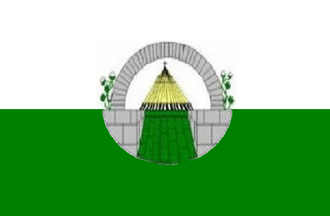 image by Aristobulo Lima,
8 May 2018
image by Aristobulo Lima,
8 May 2018 
Last modified: 2018-08-04 by ian macdonald
Keywords: rio grande do norte | patu |
Links: FOTW homepage |
search |
disclaimer and copyright |
write us |
mirrors
 image by Aristobulo Lima,
8 May 2018
image by Aristobulo Lima,
8 May 2018
The municipality of Patu (12,776 inhabitants in 2017; 31,912 ha)
is located 320 km west of Natal, on the border with Paraíba.
Patu,
originally settled by the Cariri Indians, was colonized in the 18th century
by cattle-breeders. The first settlers, coming from Apodi, were Father
Francisco Pinto de Araújo, Colonel Antônio de Lima Abreu Pereira, and
Captains Leandro Saraiva de Moura and Geraldo Saraiva de Moura. Some of
their original houses still exist. Geraldo Saraiva de Moura was appointed on
7 July 1777 manager of the estate of Nossa Senhora das Dores, established on
a plot offered by Captain Inácio de Azevedo Falcão.
Patu de Dentro
was established in 1852, as a district of the municipality of Imperatriz
(today, Martins). The municipality of Patu was established in 1890. Since
then, the districts of Almino Afonso, Messias Targino, Olho D´água do Borges
and Rafael Godeiro separated from Patu to form distinct municipalities.
Nicknamed the Town of the Winds, Patu is considered as one of the
world's best spots for paragliding and hand gliding.
https://patu.rn.gov.br, Official website
Ivan Sache, 22 July 2018
The emblem features the Lima sanctuary, dedicated to Our Lady of the Impossibilities. This dedication refers to the three characters of the Blessed Virgin that are not attainable to human being: her immaculate conception, her status of mother as a virgin, and her status of God's mother.
Colonel Antônio de Lima Abreu Pereira and his wife, Paula Moreira Braga Pessoa, erected on 29 January 1758 a chapel to house a statue of the Virgin brought from Portugal. The tradition said that the colonel, lost in the forest during a hunting party, invoked the Virgin and vowed to establish a chapel, were he to be rescued. Thirty years later, the colonel offered the chapel to the bishop. The sanctuary has been managed since 1920 by the Missionaries of the Holy Family, a congregation established in 1895 by a French priest, Jean-Baptiste Berthier (1840-1908). On 7 February 1921, Father José Scoll was appointed the first administrator of the sanctuary by the bishop of Natal, Antônio dos Santos Cabral. The chapel, rebuilt in the 19th century, was soon too small to welcome pilgrims. The building of the present-day chapel was organized by Father Henrique Spitz (1903-1979), a missionary of German origin, appointed manager of the sanctuary in 1948. The works included the building of an access road, a barrage and a beach. The chapel, whose building had started on 20 January 1967, was inaugurated on 1 January 1969.
The Lima sanctuary was awarded the unofficial title of "13th basilica of Rio
Grande del Norte". By popular vote, it was selected among the Seven Wonders of
Rio Grande del Norte.
http://www.santuariodolima.com.br/p/historia.html, Official website
On the flag in actual use, the stones beneath the sanctuary are dark gold
instead of green as represented on the self-standing emblem.
Photos:
https://patu.rn.gov.br/patu-127-anos-de-emancipacao-politica/, especially
https://assets.patu.rn.gov.br
Ivan Sache, 22 July 2018